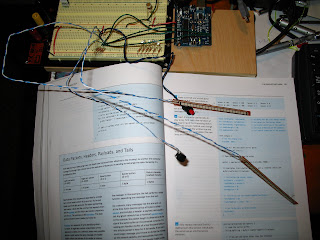
Got up to PG 62. in Making Things Talk. Setup two pushbutton switches and the 2 flex sensors.
Typed in the processing program that reads the sensor input and ran the arduino with the program to send out the sensors and button data. Didn't work the first time but went through the code line by line to find my typos. So far the text has been excellent!
The analog input seems to take values of 0-1023. I tried a photo resistor in one of the arduino tutorials and had one that get values of 23 up to 700 or so. I thought that was pretty good. With the flex sensor I get low values of around 255 up to 550, which is not as great but a reasonable workable amount to variation.
If you notice the photo resistor and 6 leds in the picture of the breadboard, I have been playing with the tutorials on the arduino site. They are workable and have the extra convenience that if you care to cut and paste code you can. I have been typing in much of the code to force my brain to learn the arduino language. Not all though. It is amazing how fast you can try stuff out if you can cut and paste useful code!
I had to get 22awg wire for the arduino since the smaller wire I had been using for breadboarding was loose in the arduino sockets. The 22awg is not as tight as I would like it but seems to be ok. Anyway this was a time that getting it at radio shack was very convenient. Having small spools can be messy but I came up with an idea of converting the 3 pack into a wire spooling tool. I cut the back open leaving it hinged and took the shrink wrap off the spools, then punched 3 holes out the opposite side for the wire from the 3 spools to unwind, threaded the wire in and got the spools back in the package and resealed the back. It actually works really well. I told Pete about it and he discovered that the plastic clamshell is not heat sealed so if you split the cardboard you can unwrap the spools and poke the holes in the plastic and reseal in a neater way. Sure it is simple but I think it is really handy.

Pete was showing off his arduino with a POV (persistence of vision) circuit. It was a bit difficult to see with the naked eye, but he thought it was because his leds were dim a heck. I agreed. The photo is in a dark area with a relatively long exposure from a tripod. You can see my ghostly image. Maybe he will put up the link to where he got the program and schematic.

No comments:
Post a Comment